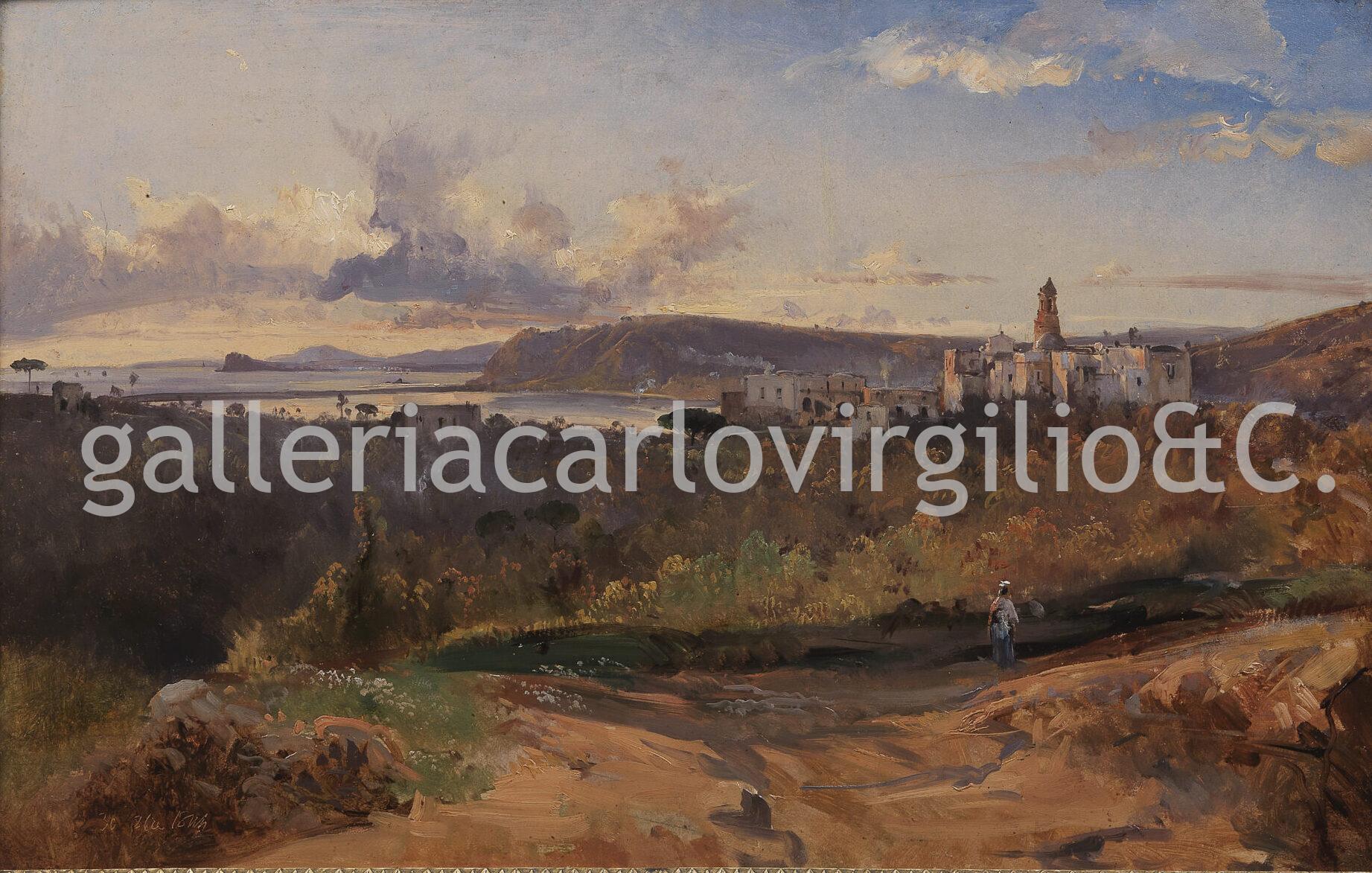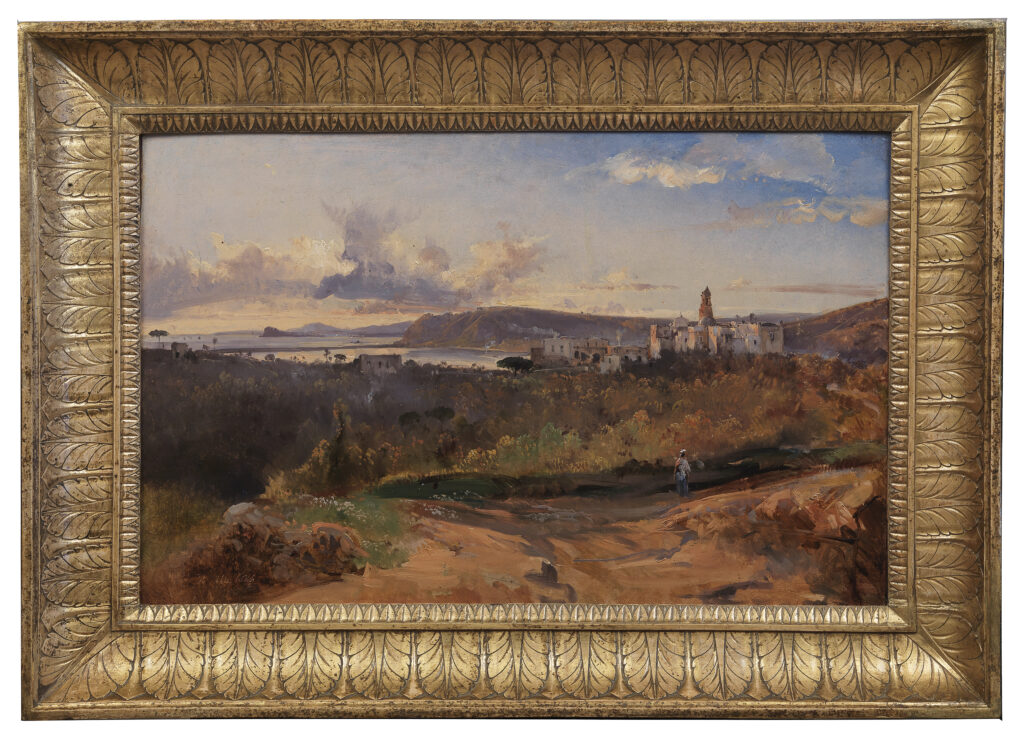| AVAILABLE

Giacinto Gigante
Naples 1806 – 1876
Landscape of Bacoli from i fondi di Baia • 1844
Oil on paper on plywood, 40 x 61,5 cm
Bottom left: 30 8bre 1844/G.Gigante
Bibliography:
Mostra di G.Gigante/luglio- Settembre 1928/ Elenco delle pitture raccolte e ordinate per cura dell’ispettore prof. S. Ortolani, Napoli [Villa Floridiana] 1928 p. 14, n. 152;
- Ortolani, Giacinto Gigante e la pittura di paesaggio a Napoli dal ‘600 all’800 (prima edizione Napoli, editore Montanino 1970, p. 207), edizione consultata, a cura di L. Martorelli, Franco di Mauro editore, Sorrento 2009, p. 181.
We are looking at a suggestive landscape of Bacoli at sunset, taken from a precise point: i fondi di Baia, or the ends of Baia, a place name that indicates the flat area of an extinct crater along the way leading from Baia to Bacoli, identifiable in the track along which the slender figure painted in the foreground is walking.
The date 30 8bre 1844 with Gigante’s signature below, both etched into the paint, perhaps with the point of a paintbrush handle, suggests the landscape was a prompt rendition made from life. The technique of oil on paper, derived from the teaching of Antoon Sminck Pitloo (1790-1837), is fruit of a shared experience when together they walked the area of the Phlegraean fields, around Bacoli, in 1823, 1827 and 1833.
The castle of Baia, located to the left of the landscape, is excluded from the view of the artist, attracted as he is by the light towards Capo Miseno, which is drawing his attention in a changing play of chromatic refractions between sea and sky where the clouds offer the spectacle of continuous movement. It is mid-autumn, and at that hour of the day when the atmospheric variations of the falling sun are reflected with a spectrum of colours going from pink to blue, to grey, to the ochre of the yellow tuff, changing intensity according to the perspective levels of nature we are looking at.
At the centre of all this nature, Bacoli stands out, with the dense cluster of Cento Camerelle, rural housing built in limestone sometimes with barrel-vaulted roofs, resistant to earth tremors, typical of the rural architecture that can also be found on the islands of Ischia, Procida and Capri. The dome and bell tower of the late seventeenth century Church of St. Anna emerge isolated and lofty from the heart of the small town. The settlement looks out over a breathtaking panorama, around the mirror of the “dead sea” or Lake Miseno, a natural bay enclosed by Mount Grillo, where, a few miles away, you can clearly make out the island of Procida, with rugged Castle D’Avalos sitting on a rock that drops sheer to the sea.
The painting belonged in the collection of Marchese Talamo Atenolfi di Cava dei Tirreni, a family (first at Cava dei Tirreni and then Rome) owning an exceptional group of works by Giacinto Gigante, including numerous watercolours sold at auction thirty or so years ago (Rome, Finarte sale, 30 May 1989) and various oil paintings. Among them is Gigante’s first painting, executed at the age of twelve, in 1818 (title: Old Fisherman, in S. Ortolani, Giacinto Gigante e la pittura di paesaggio a Napoli dal ‘600 all’800, ed. by L. Martorelli, Naples ed. 2009, Franco di Mauro editore, Sorrento, p. 16).
The landscape in oil of Bacoli was already known to Sergio Ortolani (1896-1949) when, in the course of his initial research into landscape painting in Naples from the seventeenth to nineteenth centuries, carried out from the late 1920s to 1944, he began to develop a passion for Giacinto Gigante, tracked down through the collectors’ network that spread between Naples (the Ferrara, Quarantotti, Gualtieri and Casciaro families) and the provinces (the Astarita family in Sorrento and the Talamo Atenolfi family in Cava dei Tirreni), still easily traceable.
The oil painting attracted the art historian’s attention both due to the originality of the compositional cut and for its particular atmosphere in which the human presence is wrapped in a unique sentiment of nature. The chromatic impasto recalls the intense palette of Pitloo, whose influence here was the approach to landscape taken from life.
This work was chosen by Ortolani for the first retrospective exhibition dedicated to Gigante, made up of 161 works by the artist, of which only seven were painted in oil and three by other artists. The exhibition was put on in 1928 at Villa Floridiana (R. Museo della villa Floridiana al Vomero/ Mostra di G.Gigante/ luglio- Settembre 1928/ Elenco delle pitture raccolte e ordinate per cura dell’ispettore prof. S. Ortolani, Naples 1928, p. 14, n. 152). On that occasion, Ortolani acted in the role of official of the Soprintendenza dell’arte Medioevale e Moderna della Campania, director of the Gabinetto pinacologico and the new Fototeca, appearing as the new Gigante expert, in opposition to the Southern Italian tradition led by Salvatore Di Giacomo, poet and writer, and thus far considered the greatest connoisseur of Gigante and the School of Posillipo (S. Di Giacomo, La Scuola di Posillipo, in “Mezzogiorno Artistico” fs. VII, gennaio-aprile 1902).
Ortolani’s interest in Gigante was certainly marked by the knowledge of a new aesthetic vision, influenced by the theory of pure visibility put forward by the philosopher Konrad Fiedler, and known through the writing of Benedetto Croce (Cfr. La teoria dell’arte come pura visibilità, Napoli 1912; B. Croce, Nuovi saggi di estetica, Bari 1920) who contributed to the spread of thinking deriving from Kant during his literary entertainments, in which Ortolani took part assiduously in the 1930s.
Following the first exhibition of 1928, research on Gigante continued in view of a publication, put on hold as a result of the second world war and published posthumously only in 1970 (S. Ortolani Giacinto Gigante e la pittura di paesaggio a Napoli dal ‘600 all’800, ed. by R. Causa, Naples, Montanino editore, 1970), in the process of systematically cataloguing Gigante’s oeuvre, Ortolani rectified the title of the painting that according to the catalogue of the exhibition at the Floridiana, was “Wliderness, above Sorrento” (Naples 1928, n. 152) instead naming it “Bacoli, the Dead Sea and Procida, 30/X/1844” (Cfr. S. Ortolani, Giacinto Gigante e la pittura di paesaggio…cit. p. 181), specifying that the Talamo collection was no longer at Cava dei Tirreni, but in Rome.
Luisa Martorelli
Naples, 27 February 2025
For further information, to buy or sell works by Gigante Giacinto (1806-1876) or to request free estimates and evaluations
mail info@carlovirgilio.co.uk
whatsapp +39 3382427650
